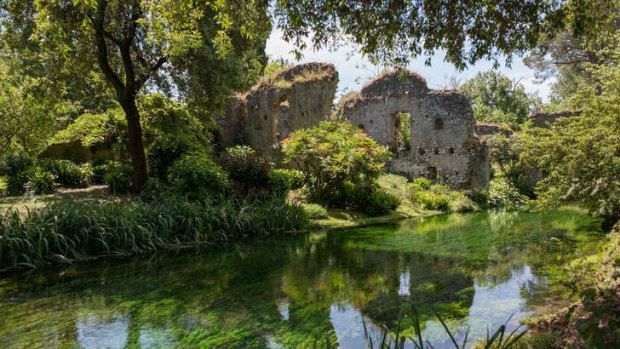
The exquisite garden dates back to the late 19th century when the aristocratic Caetani family took over lands deserted for centuries including Ninfa, a town that was abandoned in the Middle Ages.Credit: AFP
Rare plants, enchanting ruins and the tinkle of waterfalls: the English-style botanical oasis of Ninfa near Rome is a secret idyll billed as "the world's most romantic garden".
The exquisite garden dates back to the late 19th century when the aristocratic Caetani family took over lands deserted for centuries including Ninfa, a town that was abandoned in the Middle Ages.
The town once had 150 homes and seven churches -- a stopping off point for pilgrims and merchants on the ancient Roman Appian Way -- but was ravaged by a civil war before becoming an artistic haven.
"Ninfa is not just a garden, it is a long cultural history," said Lauro Marchetti, head of the Roffredo Caetani Foundation, which manages the garden some 70 kilometres from Rome.
Caetani's mother, an Englishwoman named Ada Wilbraham, was the founder of the garden.
Caetani, a musician and a protege of Hungarian composer Frantz Liszt, came up with the streams and waterfalls to create bewitching melodies.
It is so romantic with the water, the roses and the ruins. In Australia, we have aquatic plants, acacias and eucalyptuses like here but there is nothing like this.
"At night in the spot that we call 'of the nightingales', there is a real concert with the birdsong and the water," Marchetti said.
Caetani's American wife Marguerite Chapin added roses, irises, peonies and a bamboo pavilion to the garden and invited her literary friends.
Virginia Woolf, Tennessee Williams, Truman Capote all visited, as well as Italian writer Alberto Moravia and cult filmmaker Pier Paolo Pasolini.
Many were inspired by the ruins of the Roman bridge, the former customs house and waters teeming with rare trout and filled with aquatic flora.
Under the arched vault of the customs house -- where reflections of the water dance on the walls -- Italian author Giorgio Bassani wrote his famous novel "The Garden of the Finzi-Continis".
"Shortly before his death, he came back here one last time. He was very ill and he told me with a heavy sigh: 'Now I can die'", Marchetti said.
The arrangement of plants from around the world is sophisticated but natural-looking, with 1,300 different species in total.
Among the rarities on display are giant rhubarbs from Brazil, witch-hazel from the Alborz mountains in Iran and cedar trees North Africa.
Banana trees, American tulips and Japanese maple can also be seen, along with a climbing rose wrapped 21 metres up a cypress tree.
Borders of the garden are in flower between April and November and were created by Lelia, the daughter of Roffredo and Marguerite Caetani, an impressionist-style painter who died in 1977.
Lelia was the last of the Caetanis and she passed on to Marchetti the challenge of safeguarding Ninfa and its rules on organic gardening.
"This garden is one of the glories of Italy. It is very well kept, a true symphony between nature and the capacity of man to cultivate a place like this," said Patrick Hennessy, the Irish ambassador to Rome, during a recent visit to the site.
The Australian envoy David Ritchie is a regular.
"I love sitting down, listening to the birds singing and the sound of the waterfalls," he said.
"It is so romantic with the water, the roses and the ruins. In Australia, we have aquatic plants, acacias and eucalyptuses like here but there is nothing like this," he said.
In order to preserve it, the foundation only organises guided visits between April and November.
There are usually around 55,000 visitors a year.
"We have to respect the tranquillity of the birds and the butterflies," Marchetti said.
The garden had a one-day record this year of 3972 visitors, even though it does not do publicity and is only known about "by word of mouth", he said.
Ticket sales help pay the salaries of five gardeners but there is no question of it ever becoming a mass market business.
Marchetti sneered: "Ninfa can never be a commercial place filled with Coca-Cola cans, plastic bags and cigarette butts."
AFP
Sign up for the Traveller Deals newsletter
Get exclusive travel deals delivered straight to your inbox. Sign up now.